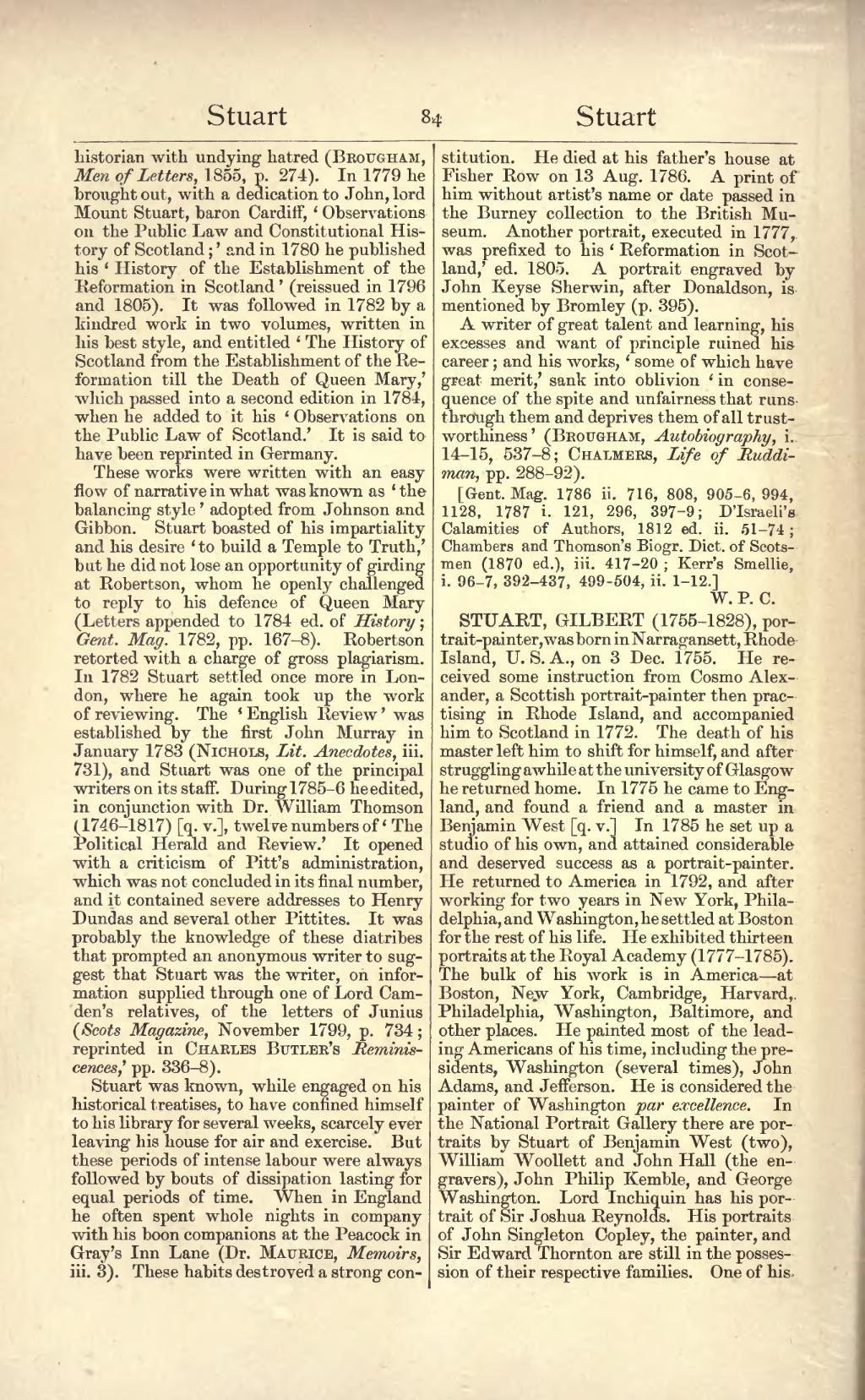historian with undying hatred (Brougham, Men of Letters, 1855, p. 274). In 1779 he brought out, with a dedication to John, lord Mount Stuart, baron Cardiff, ‘Observations on the Public Law and Constitutional History of Scotland;’ and in 1780 he published his ‘History of the Establishment of the Reformation in Scotland’ (reissued in 1796 and 1805). It was followed in 1782 by a kindred work in two volumes, written in his best style, and entitled ‘The History of Scotland from the Establishment of the Reformation till the Death of Queen Mary,’ which passed into a second edition in 1784, when he added to it his ‘Observations on the Public Law of Scotland.’ It is said to have been reprinted in Germany.
These works were written with an easy flow of narrative in what was known as ‘the balancing style’ adopted from Johnson and Gibbon. Stuart boasted of his impartiality and his desire ‘to build a Temple to Truth,’ but he did not lose an opportunity of girding at Robertson, whom he openly challenged to reply to his defence of Queen Mary (Letters appended to 1784 ed. of History; Gent. Mag. 1782, pp. 167–8). Robertson retorted with a charge of gross plagiarism. In 1782 Stuart settled once more in London, where he again took up the work of reviewing. The ‘English Review’ was established by the first John Murray in January 1783 (Nichols, Lit. Anecdotes, iii. 731), and Stuart was one of the principal writers on its staff. During 1785–6 he edited, in conjunction with Dr. William Thomson (1746–1817) [q. v.], twelve numbers of ‘The Political Herald and Review.’ It opened with a criticism of Pitt's administration, which was not concluded in its final number, and it contained severe addresses to Henry Dundas and several other Pittites. It was probably the knowledge of these diatribes that prompted an anonymous writer to suggest that Stuart was the writer, on information supplied through one of Lord Camden's relatives, of the letters of Junius (Scots Magazine, November 1799, p. 734; reprinted in Charles Butler's Reminiscences, pp. 336–8).
Stuart was known, while engaged on his historical treatises, to have confined himself to his library for several weeks, scarcely ever leaving his house for air and exercise. But these periods of intense labour were always followed by bouts of dissipation lasting for equal periods of time. When in England he often spent whole nights in company with his boon companions at the Peacock in Gray's Inn Lane (Dr. Maurice, Memoirs, iii. 3). These habits destroyed a strong constitution. He died at his father's house at Fisher Row on 13 Aug. 1786. A print of him without artist's name or date passed in the Burney collection to the British Museum. Another portrait, executed in 1777, was prefixed to his ‘Reformation in Scotland,’ ed. 1805. A portrait engraved by John Keyse Sherwin, after Donaldson, is mentioned by Bromley (p. 395).
A writer of great talent and learning, his excesses and want of principle ruined his career; and his works, ‘some of which have great merit,’ sank into oblivion ‘in consequence of the spite and unfairness that runs through them and deprives them of all trustworthiness’ (Brougham, Autobiography, i. 14–15, 537–8; Chalmers, Life of Ruddiman, pp. 288–92).
[Gent. Mag. 1786 ii. 716, 808, 905–6, 994, 1128, 1787, i. 121, 296, 397–9; D'Israeli's Calamities of Authors, 1812 ed. ii. 51–74; Chambers and Thomson's Biogr. Dict. of Scotsmen (1870 ed.), iii. 417–20; Kerr's Smellie, i. 96–7, 392–437, 499–504, ii. 1–12.]
STUART, GILBERT (1755–1828), portrait-painter, was born in Narragansett, Rhode Island, U.S.A., on 3 Dec. 1755. He received some instruction from Cosmo Alexander, a Scottish portrait-painter then practising in Rhode Island, and accompanied him to Scotland in 1772. The death of his master left him to shift for himself, and after struggling awhile at the university of Glasgow he returned home. In 1775 he came to England, and found a friend and a master in Benjamin West [q. v.] In 1785 he set up a studio of his own, and attained considerable and deserved success as a portrait-painter. He returned to America in 1792, and after working for two years in New York, Philadelphia, and Washington, he settled at Boston for the rest of his life. He exhibited thirteen portraits at the Royal Academy (1777–1785). The bulk of his work is in America—at Boston, New York, Cambridge, Harvard, Philadelphia, Washington, Baltimore, and other places. He painted most of the leading Americans of his time, including the presidents, Washington (several times), John Adams, and Jefferson. He is considered the painter of Washington par excellence. In the National Portrait Gallery there are portraits by Stuart of Benjamin West (two), William Woollett and John Hall (the engravers), John Philip Kemble, and George Washington. Lord Inchiquin has his portrait of Sir Joshua Reynolds. His portraits of John Singleton Copley, the painter, and Sir Edward Thornton are still in the possession of their respective families. One of his
